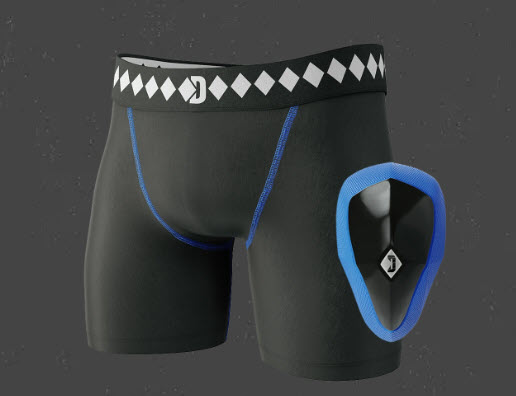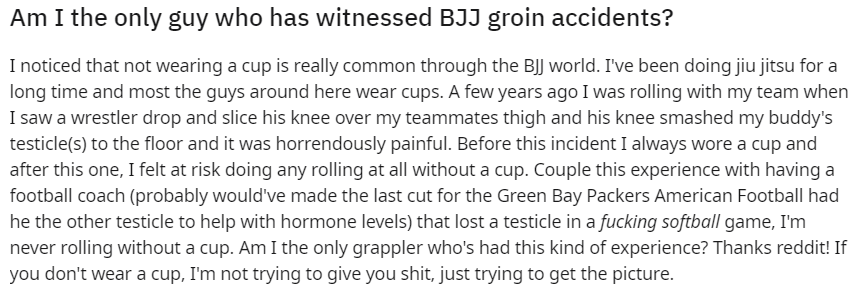
The Jiu-Jitsu Cup vs. No-Cup Debate Rages On
The “Cup vs. No-Cup BJJ Debate”
There is much debate as to whether jiu-jitsu practitioners should wear a cup or not with strong convictions on both sides of the argument.
Much of the argument comes down to personal perspective (and perhaps how long you have been practicing the art).
There are those that abide by the long-standing code that originated back in the early days of jiu-jitsu in Brazil who are very opposed to wearing a cup. Their arguments include, but are not limited to:
- That’s not how they practiced jiu-jitsu back in the early days.
- IBJJF does not allow cups in competition so you should get used to that from the start.
- There are no cups in self-defense on the streets.
- A cup provides an advantage because it acts as a strong fulcrum during certain techniques like armbars.
- A cup can be uncomfortable for your training partner while rolling.
- “I don’t wear a cup and have never experienced an injury. Therefore, it is unnecessary.”
These are all understandable and reasonable perspectives.
But for each of the above arguments, there are equally solid counter-arguments from the other side of practitioners who prefer to wear a cup.
The reality is, a cup is just one of many types of protective gear often used in contact sports. The emphasis is on “PROTECTIVE GEAR.”
During the first two years of my jiu-jitsu journey, I had a continuous problem with cracked ears resulting in cauliflower problems which required frequent and painful draining. It was happening about every other month. Whether it was a knee banging against my ear from an attempted triangle, mashing during a tight pass, or heads banging during takedowns, my home supply of needles, magnets, and bandages would have made a heroin addict jealous. I didn’t care if other jiu-jitsu practitioners thought cauliflower ear was cool, I wanted no part of it. That was my choice. It didn’t mean I didn’t love jiu-jitsu.
As a result, I started to wear headgear. It was soft-headgear and the headgear was made specifically for jiu-jitsu and it allowed me to keep rolling when cracked ears where on the menu. It wouldn’t take much of an imagination to guess that it brought out various comments from others at the jiu-jitsu school. “Hey, nice looking bra on your head!” Or, “Hey ear-muffs, do you want to roll?”
I got used to the headgear within days and always felt more comfortable and safer wearing it. I never got comfortable with the endless negative comments. I found them demeaning, annoying, and childish. At the end of the day, I began wearing the headgear at every class whether my ears were cracked, or they weren’t. I used it as protective gear to avoid injuries that could be prevented from the start.
Protective gear isn’t limited to headgear. There was a teammate of mine that was an older gentleman who wore a knee brace. Let’s just say that the knee-brace was, “robust” in design and construction. More than once someone would complain that the knee-brace was uncomfortable when the athlete was in 50/50 position or single-X. Now mind you, this was an older athlete and he felt that his choices were to either roll with the knee-brace on or not roll at all. For all intents and purposes, his knee was worn out and most likely in need of full-knee replacement surgery.
To add, knowing his personality and rolling style, if at any point during the roll, someone said, “Hey, your knee brace is jabbing into my leg and it is uncomfortable,” he would have quickly stopped and agreed to reset into any position that his training partner wanted to reset into. To him, he just wanted to roll. If there were others who didn’t want to roll with him and would prefer to avoid him, he was also fine with that as well. All he needed was one or two willing training partners to satisfy his itch to be on the mats and enjoy jiu-jitsu. To him, the knee-brace was just his preferred use of a piece of protective gear that allowed him to enjoy rolling and practicing jiu-jitsu.
While many will argue against protective gear because “The chances of an injury are small” that’s not a reason for some practitioners to avoid using protective gear. The chances of knocking out a tooth are small, but wearing a mouthguard is considered mandatory for a segment of practitioners. Others will claim that a mouthguard impedes their breathing and refuse to wear a mouthguard. To each their own. Nobody is forcing someone to use a mouthguard or any form of protective gear.
When it comes to the family jewels, arguments erupt. While some state that the incidence rate of serious injury to testicles is small, anyone reasonable and willing to do the tiniest bit of research will discover that serious injuries to testicles are a legitimate risk in contact sports including submission grappling. Just because a serious testicle injury hasn’t happened to you, doesn’t mean that it hasn’t happened to someone else.
After doing research, I quickly found several reported incidents of very serious injuries that required surgery or even the loss of a testicle as a result of a jiu-jitsu injury. Google, “Testicle injuries jiu-jitsu” and you will see many threads started from practitioners that have incurred very serious injuries to their testicles during jiu-jitsu practice.
The comments to these threads show the magnitude of the ongoing debate with both sides making their arguments clear;
“There is a very low rate of testicle injury in jiu-jitsu. I’ve practiced for 5 years and have never injured my balls.” Versus, “I’ve driven a car for 5 years and have never been in a serious car accident. But that doesn’t mean I’m not going to wear my seatbelt.”
“Most black belts don’t wear a cup.” Versus, “Most black belts grew up where wearing a cup was frowned upon and are just passing on what was socially acceptable at that time.”
“People should learn to roll under control and not spaz out rather than wearing a cup.” Versus, “I guess we should all stop wearing mouthguards to protect ourselves against spazzy partners and accidents then under that logic???”
“It’s an advantage with armbars and certain joint locks to wear a cup.” Versus, “Yeah, and the only reason why you didn’t escape from that full-on armbar that you got caught in was because your opponent was wearing a cup…”
“It’s uncomfortable when my partner’s cup digs into me when he is on my back.” Versus, “Yeah, because being belly down with your partner’s hooks in and being bent back with a rear-naked choke isn’t the problem. The uncomfortableness is the cup in your lower back…”
“A cup is a weapon.” Versus, “We never hear from the color-commentators in MMA when a submission by arm-bar is won and the commentator points out how the armbar would never have worked without the use of the cup by the offensive opponent. Or we never hear that the rate of arm-bar submissions in MMA is higher than in sport jiu-jitsu because they can wear a cup and in IBJJF you can’t.”
“IBJJF doesn’t allow cups so you shouldn’t practice in one.” Versus, “Well less than 5% of people compete in IBJJF, many practitioners don’t care about IBJJF, and out of all the time we spend in jiu-jitsu, less than 0.1% of our time is spent in IBJJF, so why shouldn’t we protect ourselves the remaining 99.9% of the time?”
Let’s take it one step further on this last argument about IBJJF not allowing protective cups in competition. What if you compete, but your preferred method of competition is MMA and your specialty is jiu-jitsu? In MMA, not only do they allow protective cups to be worn, THEY MANDATE THEM! Wouldn’t it make logical sense to practice in the very equipment that you are mandated to use when your life and career are on the line? Why does everyone’s jiu-jitsu decisions have to always revolve around what IBJJF allows in competition? What if you like doing heel hooks in no-gi at blue and purple belt levels? What if you like doing MMA? What if you like to compete in jiu-jitsu tournaments where they do allow protective cups to be worn? (In your face IBJJF snobs…)
If we are really preaching, “Practice jiu-jitsu safely” and “protect yourself and your training partner”, then we need to be open to the fact that each practitioner may feel more comfortable wearing their own form of protective equipment and this may be different than your own personal preference. Some will wear ankle braces, tape their fingers, knee-braces, elbow pads, rib protectors, mouthguards, headgear, and cups/jock-straps.
We all should be open-minded enough to let each practitioner make that call for themselves so long as the equipment that they use isn’t causing injuries to their training partners. I have never heard of someone getting seriously injured and missing jiu-jitsu practice because they were injured by their partner who was wearing a cup. But I’ve definitely heard of times where people got seriously injured which caused them to miss jiu-jitsu practice as a result of not wearing a cup.
I know of a married brown belt (now a black belt) that severely injured one of his testicles during jiu-jitsu practice. He often complained about it when at practice how his balls were swollen while also enduring serious pain and discomfort. To make matters worse, he and his wife were attempting to get pregnant and he was having several fertility issues. Swollen balls from jiu-jitsu made matters much worse at home with his wife and was adding a lot of strain to the marriage. When I asked why he didn’t wear a cup to let things heal, he said he wouldn’t because of the social stigma of wearing a cup at the jiu-jitsu school. Guess how happy his wife was with him over his decisions? Guess how much she began to love jiu-jitsu?
I’ve been to other jiu-jitsu schools (run by very legitimate black belts from the highest pedigrees and lineage) that advised all of their students to wear a cup as THEY WORE A CUP THEMSELVES at every class.
If you don’t want to roll with a partner because of their chosen preferred use of protective gear, then you should feel comfortable enough to openly and honestly communicate it. It doesn’t mean that the other person won’t understand or that you can’t be friends. My guess is that the other person would understand and won’t care if you don’t want to roll with them. They are just making sure that they could roll themselves and feel more comfortable wearing their preferred protective gear.
As jiu-jitsu continues to grow globally, and more people of all different backgrounds are practicing the art, there are a lot more situations for various physical limitations. We now have practitioners who are paralyzed, or missing limbs, who suffer from PTSD, or were abused, or have chronic health conditions, or physical ailments. Everybody is different. They all have a story and a unique set of circumstances. When it comes to protective gear, we need to keep an open mind. Nobody is forcing you to roll with anybody. You should be free to turn down any roll that you don’t want. We are all doing this for health and enjoyment. We don’t “HAVE” to do jiu-jitsu, we “GET” to do jiu-jitsu.
So if some jiu-jitsu practitioners are tired of taking knees to the balls from overzealous knee-slicers, or they just want to take protective precautions to decrease the chance for injury, keep an open mind. Nobody is telling you that your opinion or preferences aren’t valid. You can choose to roll without a mouthguard while others choose and prefer to wear a cup. It’s ok. Jiu-Jitsu is going to keep growing one way or another. Go with the flow.
What if the entire reason that you and others at your school don’t wear a cup is that the head instructor or owner at your school came up as a colored belt not wearing a cup and passes that old-school philosophy down to the next generations? Now maybe you too get to enjoy repeated knees and elbows to the groin because, “That’s how we used to do it and since that’s how I did it, now you have to as well.” You should just toughen up your balls because that’s more manly. You can protect your knees, elbows, fingers, ears, and mouth/teeth, but don’t you dare protect your balls. That makes you a wimp.
Maybe your school is still whipping people in a hazing ritual gauntlet until they bleed when they get belt promotions too? Sounds enjoyable for the entire family. Fair enough…
It’s important to keep things in proper perspective. The puzzle of jiu-jitsu has always been (and always will be) how to get in the most training volume over the longest period of time. That is done much easier being injury-free and proactively reducing the likelihood of injuries. If you need to tape-up, then tape-up. If you need a knee brace, then put on a knee brace. If you want to wear headgear or use a mouthguard, then go for it. Need to wear Tiger Balm? I’ll put up with your smelly-self. If you want to wear a cup, then protect the family jewels. Let’s roll and have fun.
It’s also important to know that no matter what you do in jiu-jitsu; tape up/not tape up, compete/not compete, like/hate cauliflower ears, you name it, there will be plenty of people that will disagree with you. Don’t fret in those cases. When people disagree with how you want your own personal journey and path to go in jiu-jitsu (or in life), it has very little to do with you and everything to do with how they view their own path and situation in life. When people disagree with you, just roll with it (pun intended.)
When I roll, I focus on the maxim, “Upgrade the software without damaging the hardware.” My balls are very valuable hardware. I consider them an essential component of my physiology. If you don’t want to wear a cup or any other form of protective gear, I respect that.
Most people that participate in the art of jiu-jitsu do it as a fun way to stay healthy. They are not professionals and they have no interest in trying to become a professional. Most will never compete seriously or compete consistently. That’s ok too. Stay safe out there. Protect yourself and your training partners. Enjoy jiu-jitsu.

















